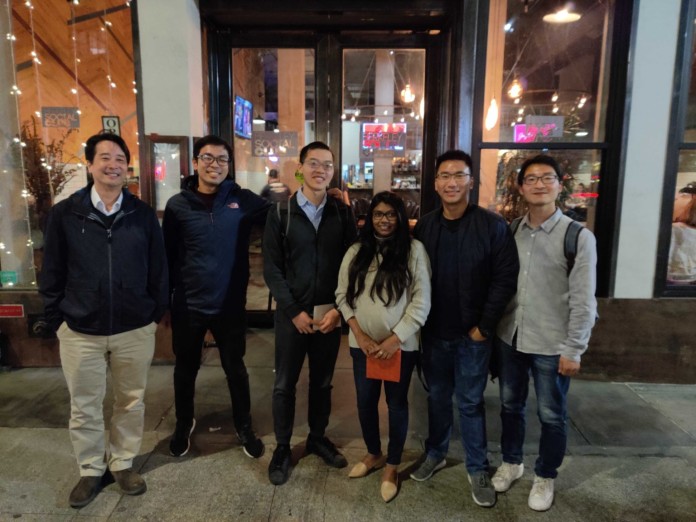Growing up in Indonesia, our contributor, Bodhinanda Chandra, realized that the quality of infrastructure in our country is still intolerably insufficient to protect people from natural disasters, and thus, requires improvement in many aspects. This motivates him to contribute as a civil engineer with hopes that one day he can build safe yet affordable houses that can protect people from disasters. This also inspired him to study abroad after high school to acquire in-depth knowledge and learn cutting-edge technology to combat natural disasters, something which he wants to bring back and introduce to Indonesia in the near future. Since fall 2019, he has been working towards a Ph.D. in GeoSystems Engineering at the University of California, Berkeley.
Read Bodhinanda’s story here.
With extensive support from many scholarship donors, in 2016, I completed my four-year undergraduate degree in civil engineering at Kyushu University, Japan. As universities in Japan put stronger emphasis in research, I have been introduced to research, particularly in the field of computational mechanics, since my last year of undergraduate, where I conducted a study on the fluid-structure interaction mechanism of bridge wash-out phenomena during tsunami for my bachelor’s thesis. The research outcome was successful and, since then, has led to several publications and awards in major conferences. Following my undergraduate degree, I continued my studies further in the same field at the Technical University of Munich (TUM) in Germany, where I earned an honored master’s degree in computational mechanics in 2019.
As many people may not be familiar with the term computational mechanics, let me briefly elaborate on that. The term computational mechanics basically designates an engineering field which tries to explain a mechanical phenomenon, let’s say flow of the wind around the surface of a car, or the vibration of an airplane during turbulence, by performing a computer simulation, involving discretization of the underlying governing equations. Within the past 50 years, computational mechanics has been a constantly growing field with impact on both science and industry in all areas of engineering. The knowledge of computational mechanics can give numerous benefits for engineers to model and explain engineering problems more accurately, safely, and efficiently. For instance, with simulation software, engineers can conduct research and their experiments without having to spend so much money for labs and equipment. Nowadays, related skills are indispensable in civil engineering, especially in understanding new construction materials, nonlinear and dynamical structural behavior, estimation of fatigue strength and failure, etc.

Trained in both civil engineering and computational mechanics, I have developed an interest in the topic of numerical modeling of phenomena involving multi-physics interaction, as understanding these phenomena is essential to understand the fundamental mechanism of most hydrological and geological hazards. I’m grateful to have the opportunity to work closely with researchers at the International Center for Numerical Methods in Engineering (CIMNE) during my master’s thesis on the modeling and simulation of environmental flow problems, such as landslides and debris flow, and their interaction with protection structures. The research was awarded the SOFiSTiK Prize 2019 by the Department of Civil, Geo, and Environmental Engineering at TUM, and brought me to a conference in Cambridge where I met my current PhD supervisor, Prof. Kenichi Soga, for the first time.
PhD in Berkeley
As a PhD student at University of California, Berkeley, my research focuses on understanding the mechanical interactions between fluid, soil, and structure as they are the three key components of many civil infrastructure. By using a method known as the Material Point Method (MPM), our research group was able to simulate a large-deformation landslide event with stunning accuracy, something which is hardly possible to achieve a decade ago.
My current task is to develop a software which can simulate the interaction of water flowing through a porous soil. The software in the long-run is hoped to give some insights to many interesting phenomena involving water-soil interaction, such as sand-boiling phenomena during liquefaction or rainfall-induced landslides, which at the moment are still very uncertain and need further investigation. Understanding these phenomena accurately will allow us, civil engineers, to design effective countermeasures for such disasters. For instance, by doing ground improvement measures or by installing protection structures on top of the unstable slope.

Next step
Through my doctoral research, I wish to contribute to the development of next-generation simulation tools which can predict complex hydro-geological hazards. As natural disasters will become more frequent and intense in the next decades due to climate change, the world needs to prepare for many changes. The rising temperature, precipitation and sea level threaten all countries, advanced and developing alike. Indonesia is no exception to this. According to the data compiled by EM-DAT, nearly 70% of all disasters that happened in Indonesia between 2000 and 2020 were weather-related. The predictive capability of these simulations would be paramount in the future, since the frequency of mass movement and other environmental flow hazards has been and will be increasing continuously due to global warming.
In the next ten years of my professional life, I hope to bring this knowledge of natural hazards simulation and prediction not only to Indonesia but also to other countries which are prone to natural disasters, as the technology is universally applicable and invariant of location. By doing this, both immediate losses and long-term social, economic, and environmental damages caused by natural disasters can be minimized significantly.
Quoting Petra Nemcova, who was one of the survivors of the 2004 Tsunami, “we cannot stop natural disasters but we can arm ourselves with knowledge: so many lives wouldn’t have to be lost if there was enough disaster preparedness.” I wish to find some clues to that knowledge.







